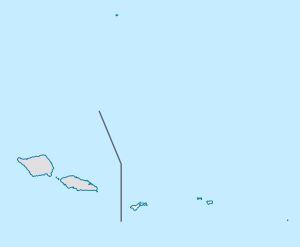world.wikisort.org - USA
Itū'au, together with Aitūlagi, make up the village of Malaeloa (long ceremonial-green).
Itū'au | |
|---|---|
Village | |
| Etymology: Samoan: "War Side" | |
 Itū'au | |
| Coordinates: 14°21′05″S 170°46′55″W | |
| Country | |
| Territory | |
| Island | Tutuila Island |
| Named for | Samoan Mythology |
| Area | |
| • Land | .23 sq mi (0.6 km2) |
| Population (2010) | |
| • Total | 550 |
| Time zone | UTC−11 (Samoa Time Zone) |
| ZIP Code | 96799 |
| Area code(s) | +1 684 |
Aitūlagi is the name of the famed family of high orator chiefs (tama matua)[1] from the Leāsina county.
Itū'au along with the villages of Fūtiga, Taputimu and Vailoatai form the itūmalo (county/district) o Tuālātai.
Although Itū'au and Aitūlagi align themselves with different counties, today they operate together in many respects as one village under the name of Malaeloa.
Tutuila Deed of Cession
Amituana'i of Itū'au was a signatory to the Tutuila Deed of Cession of 1900.[2]
Etymology
Itū’au can literally be translated as "war side".[3] The itū'au and the alātaua (war path) were roles assumed by allied villages or districts during times of conflict. This was a common practice throughout pre-contact Samoa,[4][5] with its roots in the first Mālietoa government.[6] The function of the itū’au role can be described as a "controller of troops",[6] whereas the alātaua role can be described as a "director of wars".[6] These functions were carried out by the tulafale (talking chiefs) of the villages or districts designated with these respective roles.[3]
Historical Sites
The Malaeloa Itū'au Olo Site (or defensive fortification), which was nominated for the National Register of Historic Places in 2015,[7] is supported by Samoan cultural histories and oral traditions relating to interregional conflicts and defenses against cannibalism during pre-contact periods. It was built to protect villagers from Tuife'ai, the legendary cannibal king of Tutuila, and his aumaga (army).[8]
Demographics
| Population growth[9] | |
|---|---|
| 2010 | 550 |
| 2000 | 627 |
| 1990 | 523 |
| 1980 | 467 |
References
- Sunia, Fofo I.F. (2009). A History of American Samoa. Amerika Samoa Humanities Council. Page 35. ISBN 9781573062992
- Sunia, Fofo I.F. (2009). A History of American Samoa. Amerika Samoa Humanities Council. Page 363. ISBN 9781573062992
- Maliko, Tavita (2012), O le Soga'miti, PHD Thesis, Page 140
- Williamson, R. W. (1967). The Social and Political Systems of Central Polynesia. Netherlands: Anthropological Publications, Page 82
- Turner, G. (1884). Samoa, a Hundred Years Ago and Long Before: Together with Notes on the Cults and Customs of Twenty-three Other Islands in the Pacific. United Kingdom: Macmillan, Page 189
- "Tumua and Pule. — Construction and significance in the Political history of Samoa | NZETC". nzetc.victoria.ac.nz.
- "National Register of Historic Places; Notification of Pending Nominations and Related Actions". Federal Register. 24 December 2015. Retrieved 22 March 2022.
- "Malaeloa Olo, U.S. National Register of Historic Properties, Accepted 1-5-2016". National Park Service. Retrieved 22 March 2022.
- "American Samoa Statistical Yearbook 2015" (PDF). American Samoa Department of Commerce.
Другой контент может иметь иную лицензию. Перед использованием материалов сайта WikiSort.org внимательно изучите правила лицензирования конкретных элементов наполнения сайта.
WikiSort.org - проект по пересортировке и дополнению контента Википедии